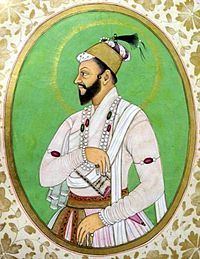Died December 4, 1661, Gwalior Parents Shah Jahan, Mumtaz Mahal | Siblings Aurangzeb Name Murad Bakhsh | |
 | ||
Burial Traitor's Cemetery (Gwalior) Spouse Sakina Banu Beguma daughter of Nawab Amir KhanSarasvathi Bai Issue Muhammad YarIzzad BakhshDostdar Banu BegumAsaish Banu BegumHamraz Banu Begum(Two sons and four daughters) Grandparents Jahangir, Taj Bibi Bilqis Makani, Abul-Hasan ibn Mirza Ghiyas Beg, Plondregi Begum Nieces Zeb-un-Nisa, Mehr-un-Nissa, Zinat-un-Nissa, Badr-un-Nissa, Zubdat-un-Nissa Similar People | ||
Murad Bakhsh - Noun Jo Khuda - Balochi Regional Songs
Muhammad Murad Bakhsh (9 October 1624 – 14 December 1661) was a Mughal prince as the youngest son of Mughal Emperor Shah Jahan and Empress Mumtaz Mahal. He was the Subedar of Balkh until he was replaced by his elder brother Aurangzeb in the year 1647.
Contents
- Murad Bakhsh Noun Jo Khuda Balochi Regional Songs
- Murad Bakhsh Lal Lagan Balochi Regional Songs
- Family
- Personal life
- Governorship
- Courtiers
- War of succession
- Military promotions
- Death
- References
Murad Bakhsh - Lal Lagan - Balochi Regional Songs
Family
Muhammad Murad Bakhsh was born on 9 October 1624, at the Rohtasgarh Fort in Bihar, as the youngest son of Emperor Shah Jahan and his beloved wife Mumtaz Mahal. Murad's siblings included his two politically powerful sisters, the princesses: Jahanara Begum and Roshanara Begum as well as the heir-apparent to his father, his eldest brother, Crown Prince Dara Shikoh and the future Mughal Emperor Aurangzeb.
Personal life
In 1638, Murad Bakhsh, at the age of fourteen years married the Safavid princess, Sakina Banu Begum, a daughter of Shah Nawaz Khan Safavi. She was the younger sister of his elder sister-in-law, Dilras Banu Begum, who was Aurangzeb's wife.
Governorship
He was appointed to Subadar of Multan (1642), of Balkh (16 February 1646 to 9 August 1646), of Kashmir (20 August 1647 to July 1648), of Deccan (25 July 1648 to 14 September 1649), and Kabul (23 January 1650 to 1654), of Gujarat (March 1654), and Malwa.
Courtiers
War of succession
On 30 November 1657, he proclaimed himself emperor at Ahmedabad, after reports that his father was ill. During the same year he received the Ottoman ambassador Manzada Husain Agha, who arrived in the port of Surat and was on his way to meet Shah Jahan in Agra. Manzada Husain Agha mentions his disappointment regarding the wars between Shah Jahan's sons.
Murad Bakhsh joined hands with Aurangzeb to defeat Dara Shikhoh, the eldest son of Shah Jahan. In fact it was the ferocious charge led by Murad Bakhsh and his Sowars that eventually turned the outcome of the battle in favor of Aurangzeb during the Battle of Samugarh.
On 7 July 1658, while he was in a tent with his brother Aurangzeb, he was intoxicated and was secretly sent to the prison and transferred to Gwalior Fort from January 1659.
He faced a trial that sentenced him to death for having murdered former Diwan clerk named Ali Naqi, in 1661. Aurangzeb then replaced Murad Bakhsh as the Subedar of Gujarat and placed Inayat Khan as the new Mughal commander of Surat.
Military promotions
Death
On 14 December 1661, after three years in prison, he was executed at Gwalior Fort. With the last of his brothers now dead, Aurangzeb was the undisputed emperor of the Mughal Empire.
